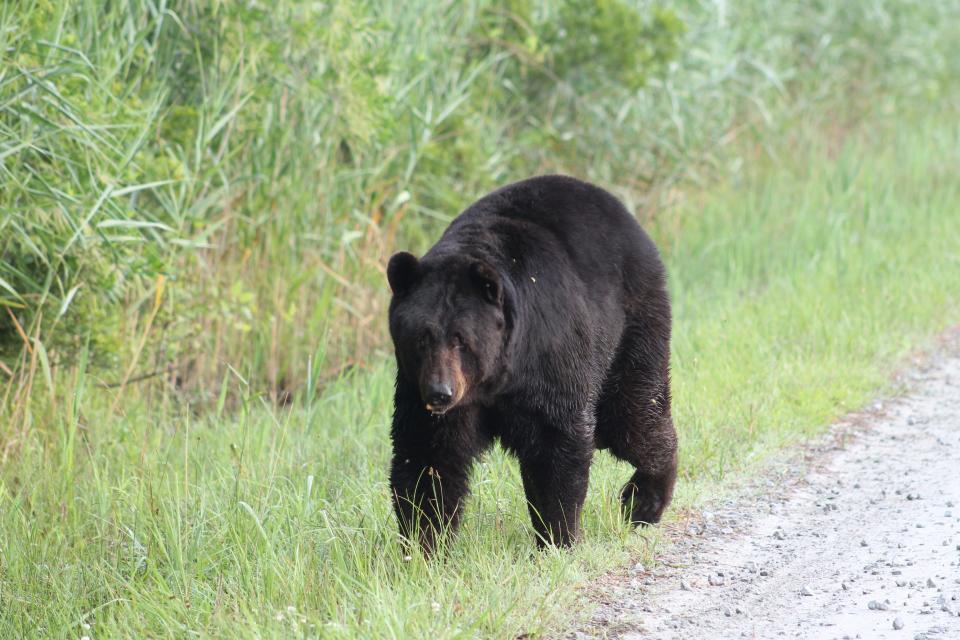Reporting every wildlife sighting is unnecessary, experts say, but here's when you should
Wildlife sightings in Craven County aren't anything new, especially during the fall or winter when they are on the hunt for a food source, experts say.
But when is it appropriate to report a wildlife sighting such as a coyote, black bear, deer or fox?
Here is when you should report wildlife and how to stay safe around these animals, according to the North Carolina Wildlife Resources Commission.
![This coyote was caught on a trail cam in a backyard on Old Vanceboro Road near Bridgeton in January. [Contributed by Alton White]](https://s.yimg.com/ny/api/res/1.2/bgyn7mc0UDB0.qL7NxEl2Q--/YXBwaWQ9aGlnaGxhbmRlcjt3PTk2MDtoPTcyMg--/https://media.zenfs.com/en/sun-journal/de38e2ee8c301084a96c1a5c5c4e41f4)
Every wildlife sighting doesn't need to be reported
A recent Facebook post on the Trent Woods Police Department page indicated coyotes may be in the area.
"We've had a couple of sightings," said Chief Tony Lee of Trent Woods Police Department. "This is not something we see all the time. We do know there are probably a few coyotes around town according to what people have told us."
There have been two reports in the span of about a month , but if you leave wild animals such as a coyote alone, they will eventually move on to other food options, Lee said.
If any wild animal is acting drunk, stumbling, falling down, walking in circles or exhibiting any type of sickness, report it, said Chris Kent, North Carolina District 2 wildlife biologist.
"Racoons and foxes are a good example," Kent said. "They are very susceptible to rabies and distemper."
In that case, a wildlife enforcement officer will go out if the situation was something that needed to be addressed immediately.
Every wild animal may be reported for different reasons.
Coyotes, for instance, sometimes prey on livestock and domestic pets, according to the Wildlife Resources Commission.
Report a coyote sighting if:
The animal fails to respond to direct hazing or acts aggressively for no reason
It is suspected to have rabies
It's engaged in threatening or dangerous activity
It's lost its natural wariness of people and fails to flee when near people
"There are certain animals that are rare in eastern North Carolina that would certainly warrant a sighting, like a weasel," Kent said.
Rare animals such as weasels, eastern diamondback rattlesnakes and coral snakes are worth reporting because of their small population.
To learn more about when to report the other hundreds of wildlife species in North Carolina visit ncwildlife.org.
What time of year can wildlife sightings increase?
Coyote pups or other wildlife are usually born in the springtime. So sightings of full-grown wild animals could peak in late September through early to mid November.
"They leave their mother and father and they disperse to go establish their own territory and home range," Kent said. "Sometimes they can disperse hundreds of miles."
Though late fall is the peak period to spot wildlife, they are seen year-round in eastern North Carolina.

Wildlife conflict and how to avoid it
People often have conflicts with wildlife damaging their property or coming onto the property and frightening them.
The peak of wildlife conflict is noticed from April through August because most species are having babies and are on the hunt for food, Kent said.
"Unfortunately, many times the people having the problem with wildlife are actually creating that problem and not even knowing it because of available food sources," he said.
There is a healthy black bear population in Craven County and Kent said he coaches people to remove their bird feeders.
Removing the food source could eliminate 90% of black bear conflict in Craven County.
Other steps to avoid conflicts with wildlife are:
Do not feed wildlife
Do not leave pet food outside
Attract birds with natural foods
Close crawl spaces and openings
Trim tree limbs
Protect gardens, beehives and chickens with fencing.
Keep small pets contained, leashed or supervised when outside.
"If people understand how to prevent conflict with them," Kent said. "There's no reason in the world where we cannot live in perfect harmony with our black bears here in the coast. They are not threatening."
This article originally appeared on Sun Journal: Wildlife sightings such as coyote or bears in Craven County

